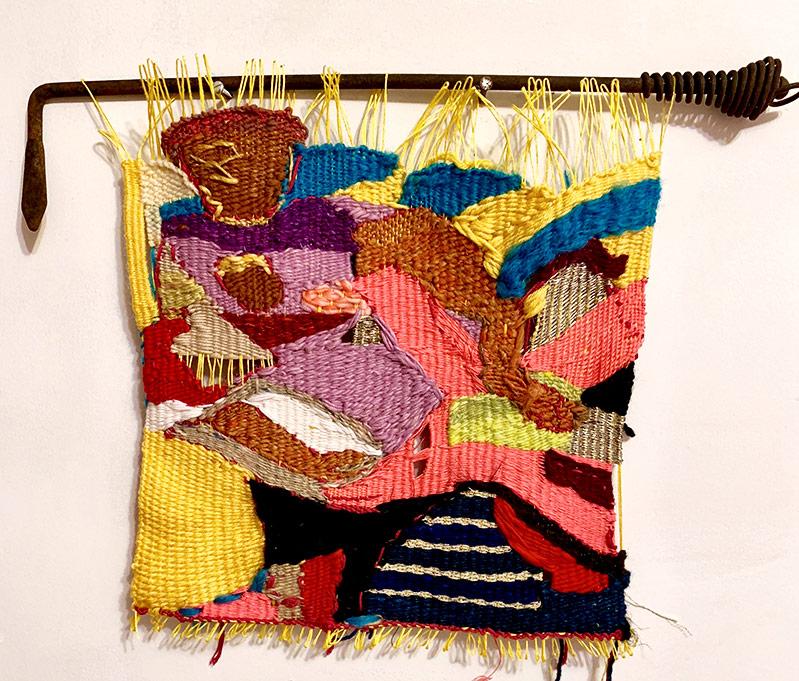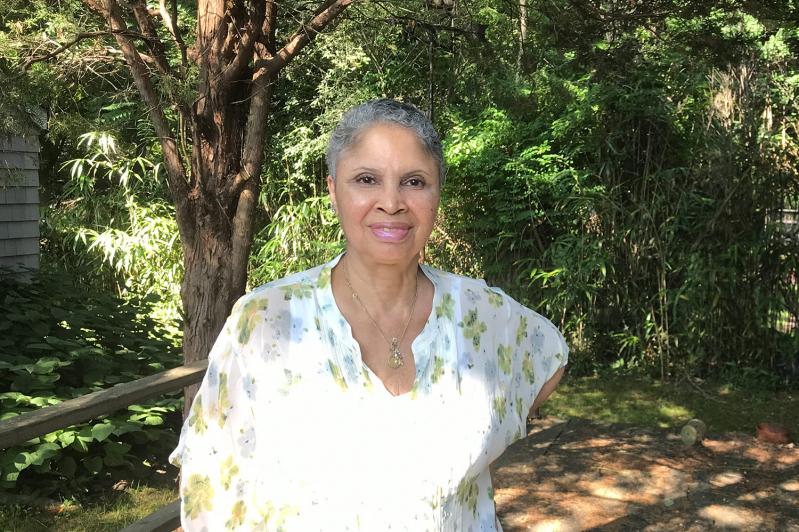“I don’t like art that is like somebody else’s stuff,” said Candace Hill Montgomery during a conversation in her Bridgehampton backyard. “I have a real hatred of things that are not original. Does it reference somebody else’s work? That’s fine. But not when it’s basically a copy.”
Ms. Montgomery has followed her own path since the age of 10, when her mother let her take the subway to art school by herself. “Hills and Valleys,” a recent exhibition of her weavings at the Sag Harbor Whaling Museum that was part of this year’s Parrish Road Show, testified to the enduring originality of her artwork some 60 years after those first classes.
She was born and raised in Queens in a neighborhood that was home to Joe Louis, Roy Campanella, James Brown, Brook Benton, Billy Eckstein, and John and Alice Coltrane. She babysat for Count Basie’s daughter. Both her parents worked for the city.
“My family has always been the artsy type,” she said, recalling her fascination with a big Miro print that hung over her parents’ bed. “But my parents weren’t happy when I got married at 17.” Her former husband was the first black art director at CBS. One of her daughters is an actor, the other a visual artist.
As a young child Ms. Montgomery spent summers at her grandmother’s farm in Alabama, where she learned crocheting, knitting, and embroidery. When she was 10, her father bought a house on Hampton Street in Sag Harbor, and the family spent summers there for many years. It was on the beach in Sag Harbor Hills that her life took another turn.
“I was about 18 or 19 and my friends and I were just sitting on the beach. One of them worked for the fashion designer Jacques Tiffeau and insisted I come into the city to meet him. I didn’t want to leave the beach, but I went in, and he hired me the same day.”
Five years of runway and print modeling followed, during which she worked for Bill Blass, Oscar de la Renta, and Chuck Howard, among others. Eventually, realizing that a career as a model wouldn’t last forever, she decided to enroll in Fordham University, where she majored in studio art and art history.
In 1979, while still an undergraduate, Ms. Montgomery was an artist-in-residence at the Studio Museum in Harlem and exhibited her work at Artists Space. Over the next decade she showed at the Bronx Museum of the Arts, the New Museum, Franklin Furnace, Fashion Moda, and the Maryland Institute College of Art, among others. She received fellowships from the National Endowment for the Arts and the Guggenheim Foundation, and earned a master’s degree in art education from Hunter College in 1981.
Ms. Montgomery’s art from that period, like her recent work, was both innovative and political. In 1979, she created two inner-city environmental sculptures. In one, “Reflections on Vacancy,” she stretched Mylar over the windows of an abandoned tenement building. “Black and White in Closure” consisted of a drydocked wooden boat in a rubble-strewn vacant lot surrounded by a black-and-white picket fence.
As part of Creative Time’s “Art on the Beach” show of outdoor installations at Battery Park City in 1981, she created “General Coldspot Memorials to Indifference in the Year of Our Lord 1981,” a 77-foot-long site-specific piece consisting of 26 refrigerators, toy military tanks, fighter bombers, and Bakelite plaques.

Her 1982 solo show at the New Museum included paintings, drawings, ceramics, and “Jade Ball Frugue Pond,” a damaged, ominous-looking wrought-iron fence suggestive of prison bars. “I saw that piece of wrought iron high up on an abandoned building across the street from where I lived. I went up there and threw it off the roof, which is how it got bent.”
Before her work turned political, the artist was making large paintings about her children and others’ enjoying the beach in Sag Harbor. “It was a more idyllic view of life,” she said. “Then I started seeing photographs of the Black Panther Party — the George Jackson case, the Angela Davis case — and that was very moving to me. My family lived in a rarefied situation. So when I realized what was going on in Oakland, I decided I had to change my work.”
In the catalog for the New Museum show, she is quoted by the curator, Lynn Gumpert: “We live in polarization, poverty, racism, violence, brutalization, and social fragmentation. . . . I want the viewer to feel what it is like to be alive and constantly under siege!”
“Since I came from an integrated family, we weren’t ever talking about race in the house,” she said in Bridgehampton. “We were just listening to music and dancing and having a good time out here in Sag Harbor along with everybody else in the upper middle class. And I decided that wasn’t the way you live your life, in a bubble.”
She acknowledges that her current work is also political, but “a different kind of political. Then, it was very in-your-face. You had to do something then. And I was so young.” In the recent work, the political component emerges through plays on words and double entendres. One example is “The Pelosi Afghan,” a woven piece that refers to the once-popular type of crocheted woolen blanket or shawl, but also to Nancy Pelosi’s planned trip to Afghanistan that was cancelled by Donald Trump.
Ms. Montgomery creates her woven pieces on handmade looms, using handspun wool that produces nuanced colorations; organically dyed yarns, horsehair, linen, mohair, leather, and silk, among other materials. To mount the pieces shown at the Whaling Museum she used found objects, including old farm equipment her father originally brought up from Alabama.
She began weaving in 2014. “I just fell in love with it, I thought it was the bomb. But I try to steer away as much as possible from fashion. I make fun of fashion.” She showed a viewer a new abstract weaving she intends to exhibit so that both sides are visible. “It’s interesting because they’re just so completely different.”
Another new series will combine weavings with small steel plates she found abandoned on a building site. “It’s going to be Donald Judd-ism,” she said, referring to the sculptor known for his copper, aluminum, and steel pieces.
“I love weaving and just want to keep doing it, but to have the ideas be different each time. I want to wonder, and for people to wonder, where that came from. You have to take your time to look at it.”
Ms. Montgomery was an art teacher for 35 years, all but five at a New York City high school. She admits that to some extent her commitment to teaching and to her children interfered with her career as an artist, but she has no regrets. She also cited the challenges faced by black artists during the 1980s, especially commercial galleries’ reluctance to show their work.
Since she retired in 2011 she has lived in Bridgehampton full-time. “When I came out here, all my work from the early years was stored in the garage, and Hurricane Sandy just ruined everything. I was invited to show at the Tate a couple of years ago, but I didn’t have any work.” She got a Dumpster, cleared it out, and now uses half of the garage as a studio.
“But it works out,” she said. “I really feel now I don’t have to be stuck in a certain niche. The abstract artists used to complain about the people who were political, and we complained about them. Now I feel I can have a different vision, where you can mix the two and say things in a much more interesting way than just putting up photographs of what was going on with the Movement.”
I was so young.” In the recent work, the political component emerges through plays on words and double entendres. One example is “The Pelosi Afghan,” a woven piece that refers to the once-popular type of crocheted woolen blanket or shawl, but also to Nancy Pelosi’s planned trip to Afghanistan that was cancelled by Donald Trump.
Ms. Montgomery creates her woven pieces on handmade looms, using handspun wool that produces nuanced colorations; organically dyed yarns, horsehair, linen, mohair, leather, and silk, among other materials. To mount the pieces shown at the Whaling Museum she used found objects, including old farm equipment her father originally brought up from Alabama.
She began weaving in 2014. “I just fell in love with it, I thought it was the bomb. But I try to steer away as much as possible from fashion. I make fun of fashion.” She shared a new abstract weaving she intends to exhibit so that both sides are visible. “It’s interesting because they’re just so completely different.”
Another new series will combine weavings with small steel plates she found abandoned on a building site. “It’s going to be Donald Judd-ism,” she said, referring to the sculptor known for his copper, aluminum, and steel pieces. “I love weaving and just want to keep doing it, but to have the ideas be different each time. I want to wonder, and for people to wonder, where that came from. You have to take your time to look at it.”
Ms. Montgomery was an art teacher for 35 years, all but five at a New York City high school. She admits that to some extent her commitment to teaching and to her children interfered with her career as an artist, but she has no regrets. She also cited the challenges faced by black artists during the 1980s, especially commercial galleries’ reluctance to show their work.
Since she retired in 2011 she has lived in Bridgehampton full time. “When I came out here, all my work from the early years was stored in the garage, and Hurricane Sandy just ruined everything. I was invited to show at the Tate a couple of years ago, but I didn’t have any work.” She got a Dumpster, cleared it out, and now uses half of the garage as a studio.
“But it works out,” she said. “I really feel now I don’t have to be stuck in a certain niche. The abstract artists used to complain about the people who were political, and we complained about them. Now I feel I can have a different vision, where you can mix the two and say things in a much more interesting way than just putting up photographs of what was going on with the Movement.”

